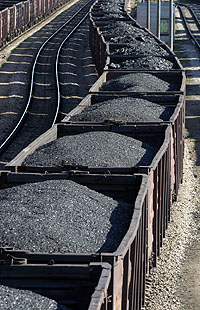I’m trying to make sense out of “Dirty Coal, Clean Future,” James Fallows’ latest piece in the Atlantic, but I’m not having much luck. In one sense it’s simple. Fallows makes two points:
-
 Like it or not, the world is going to be using a lot of coal for a very long time.
Like it or not, the world is going to be using a lot of coal for a very long time. - China and America are collaborating very nicely on development of clean coal technology.
But collaborating on what? Here’s where it gets confusing. Primarily, there’s the fact that China is just building lots and lots of coal plants, which provides a lot of scope for experimentation:
In the search for “progress on coal,” like other forms of energy research and development, China is now the Google, the Intel, the General Motors and Ford of their heyday — the place where the doing occurs, and thus the learning by doing as well. “They are doing so much so fast that their learning curve is at an inflection that simply could not be matched in the United States,” David Mohler of Duke Energy told me.
….“You can think of China as a huge laboratory for deploying technology,” the official added. “The energy demand is going like this” — his hand mimicked an airplane taking off — “and they need to build new capacity all the time. They can go from concept to deployment in half the time we can, sometimes a third. We have some advanced ideas. They have the capability to deploy it very quickly. That is where the partnership works.”
But this type of progress, Fallows says, is strictly incremental. The Chinese are building new plants that are a bit more efficient or a bit cheaper or a bit cleaner, but even decades of this will only amount to modest improvements. When it comes to really getting the carbon out of coal, there’s still only one way to do it: via sequestration. That is, capture the CO2 somehow and pump it underground where it will (hopefully) stay put forever. As Fallows notes, the U.S., Europe, and Australia have been building experimental sequestration facilities for many years now, and so far nothing has gotten beyond the small-scale stage. But:
America’s FutureGen was proposed early, and China’s GreenGen was proposed late. Now — surprise! — GreenGen is closest to being completed, with its scheduled opening moved up from 2015 to 2013, and FutureGen has only recently begun to move beyond the congressional-wrangling stage.
No question about it: FutureGen has been plagued with difficulties. But what about GreenGen? Will it work? Are they using any innovative tech? Is it cost effective? Is it really any better than any of the world’s other sequestration demonstration projects?
It’s a mystery. There’s nothing further in the piece about GreenGen, and it’s the only piece of the puzzle that provides any hope of seriously reducing the carbon emissions of coal plants. So I’m not sure what to think. All the collaboration sounds wonderful, and even a 20% or 30% improvement in coal technology would be welcome. But that said, sequestration is the holy grail and I still don’t know if the Chinese are doing anything more on that front than the rest of us. Maybe that’ll be in the sequel.

















